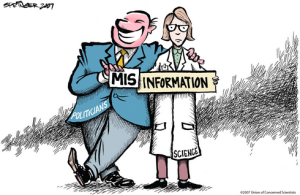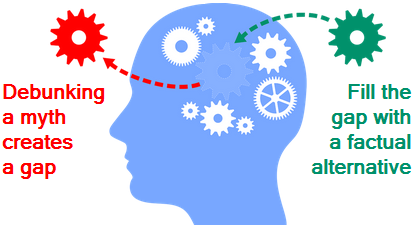
Science denial. [source]
In part 1 of this snack, I discussed the consensus gap that exists between the scientific community and the general public, the difference between a science sceptic and a science denier and the five common characteristics of science denial (F.L.I.C.C.). Now that we understand how science denial generally manifests, I want to elaborate on methods to deal with and debunk climate science denial in this second part.
Dragons of inaction
Before I dive into these methods, I want to discuss why it is important that the general public is well-informed on the science of climate change. To minimise the harmful effects of climate change, global measures of adaptation and mitigation are required. The public has an important role here: they can make changes to their own behaviour, but also, they are in a position to demand action from politicians and companies. Of course if the public doesn’t see a problem, they won’t feel the need or urgency to act.
 There are five psychological barriers that prevent people from acting on climate change, the ‘dragons of inaction’ [1]:
There are five psychological barriers that prevent people from acting on climate change, the ‘dragons of inaction’ [1]:
1. Spatial discounting is an example of such a dragon, people tend to discount events that are far away in space or time. For climate related issues people tend to think the grass is greener on their side.
2. Likewise, people tend to be optimistic about personal risks in the face of climate change.
3. Pessimism about the impact of personal actions against global challenges like reforming energy production methods is another dragon of inaction.
4. The fourth dragon is social norming, i.e. comparing personal actions against those of people around us.
5. Token behaviour, when people use small changes they have made as an excuse to avoid larger, more difficult changes, is the final dragon.
Recently the scientific consensus gap was found to be an important, extra dragon of inaction. When the public is aware of the scientific agreement on climate change (it is happening, it is dangerous and we are causing it) they are more likely to accept that climate change is real and current. Consequently they are more likely to support policies to mitigate or adapt to its effects.
Myth busting
To close the consensus gap and increase public understanding of climate science, scientists (that’s us!) therefore have to debunk climate myths and act on climate science denial. To maximise the effects of our efforts, we can frame our actions according to results of social and psychological science experiments. For example, simply communicating scientific evidence will not work with everyone, it may even backfire, causing the belief of denial to become stronger. I’ll explain this counter-intuitive process later.
 ‘Inoculation theory’ is a popular psychological metaphor of effective learning. It describes how people become resistant to misconceptions [2]. In this theory there are two types of information: vitamins and flu shots. Start your argument with vitamins: the facts, the simple understanding of scientific principles. However, vitamins alone might not provide the tools to identify and debunk a climate myth. Therefore you should add a flu shot to your argument: a weak version of the denial virus. A flu shot introduces a myth and then explains the fallacy that is used to change the science. Such ‘misconception based learning’ has been proven to be very effective. People gain more knowledge and, more importantly, become more resistant to misinformation.
‘Inoculation theory’ is a popular psychological metaphor of effective learning. It describes how people become resistant to misconceptions [2]. In this theory there are two types of information: vitamins and flu shots. Start your argument with vitamins: the facts, the simple understanding of scientific principles. However, vitamins alone might not provide the tools to identify and debunk a climate myth. Therefore you should add a flu shot to your argument: a weak version of the denial virus. A flu shot introduces a myth and then explains the fallacy that is used to change the science. Such ‘misconception based learning’ has been proven to be very effective. People gain more knowledge and, more importantly, become more resistant to misinformation.
Due to global warming, warm days will become more common and cold days less common. Global warming is a gradual change in the mean climate. However, global warming does not stop weather from happening, not even cold weather! Claiming that a cold winter or an unexpected snow storm disproves global warming is happening is therefore a false expectation, a climate myth.
 As I (and maybe others) have encountered, debunking myths is not as simple as you think. Again the field of psychology gives us the reason why. People develop mental models, cogs fitting together, of how the climate works. If you take out a cog because it is based on a misconception, you create a gap in this model. If the gap is not filled with an alternative cog that fits the model well, the person will reject the new cog (the fact) and become more attached to the faulty cog (the myth): the debunking effort has been counterproductive!
As I (and maybe others) have encountered, debunking myths is not as simple as you think. Again the field of psychology gives us the reason why. People develop mental models, cogs fitting together, of how the climate works. If you take out a cog because it is based on a misconception, you create a gap in this model. If the gap is not filled with an alternative cog that fits the model well, the person will reject the new cog (the fact) and become more attached to the faulty cog (the myth): the debunking effort has been counterproductive!
Global warming is the result of an anthropogenic enhancement of the natural greenhouse effect. A common myth concerning climate change is that global warming is caused by the Sun. If that were the case we would expect temperatures to rise faster during the day than at night. In places with no greenhouse effect (the Moon) there is a large daily cycle, in places with an extreme greenhouse effect (Venus) there is no daily cycle. Evidence shows that nights warm faster than days [3]. Earth is moving to be more like Venus than like the Moon. Not because of the Sun, but because of increased concentrations of greenhouse gasses.
Finally, when fighting science denial, it is important that you emphasise the facts, not the myths. People only remember parts of what they are told. If the emphasis in your argument is wrong, they might remember the myth rather than the facts. Hence, to make your argument most effective, it should comprise of three key elements: the fact, the myth and the fallacy. Start with the facts, then provide a warning a myth is coming and mention the myth, last explain which fallacy (F.L.I.C.C.) is used and how the argument denies the existing science.
As a result of global warming, worldwide glaciers are losing mass. For example, the West Antarctic ice sheet is losing 118 billion tonnes of ice each year [4] and Greenland loses ice at a rate of 180 billion tonnes a year [5]. By contrast, the East Antarctic ice sheet is gaining mass (60 billion tonnes per year [4]). Using this particular East Antarctic ice sheet as an argument against global warming is an example of cherry picking, the myth ignores the majority of global glaciers that are in fact losing mass. In East Antarctica ice loss at the coast due to melting and calving is balanced by increased snow fall in the interior of the land mass [6]. Both, the increased melt and the increased snow fall, are the result of regional warming.
To increase the likelihood of people remembering your argument, use ‘sticky science’. Sticky science is science that is a Simple, Unexpected, Credible, Concrete and Emotional Story (S.U.C.C.E.S) [7]. Keep it simple, so people can build a mental model. Unexpected or counter-intuitive science will take people by surprise, which increases the likelihood of people remembering it. An argument based on peer-reviewed papers is more credible. A metaphor or a simple figure makes science more concrete. Emotional messages will also be remembered more easily and finally, stories or narratives are easier to remember and reproduce. In the small examples of climate myth busting above, I have tried to follow the given advice: I have given out flu shots, warned when I dealt with a climate myth, kept the emphasis on the facts and, where possible, made it sticky.
Concluding remarks
In the two parts of my ClimateSnack contribution on climate science denial I have summarised what I thought were the most important messages from the online course ‘Denial101x: Making Sense of Climate Change Denial’. I hope you are now better equipped to fight climate myths. Understanding the common characteristics of denial and being familiar with psychological methods like inoculation theory and sticky science will help greatly. And, although there will always be a minority that doesn’t want to know the truth, I am sure most –currently– misinformed people will thank you for your debunking efforts.
References
[1] R. Gifford (2011): The dragons of inaction: Psychological barriers that limit climate change mitigation and adaptation. American Phsychologist, 66, 290-302, doi: 10.1037/a0023566.
[2] W.J. McGuire (1961): The effectiveness of supportive and refutational defenses in immunizing and restoring beliefs against persuasion. Sociometry, 24, 184-197, doi: 10.2307/2786067.
[3] L.V. Alexander, X. Zhang, T.C. Peterson, J. Caesar, B. Gleason, A.M.G. Klein Tank, M. Haylock, D. Collins, B. Trewin, F. Rahimzadeh, A. Tagipour, P. Ambenje, K. Rupa Kumar, J. Revadekar, G. Griffiths (2006): Global observed changes in daily climate extremes of temperature and precipitation. Journal of Geophysical Research Atmospheres, 111, D05109, doi: 10.1029/2005JD006290.
[4] M.A. King, R.J. Bingham, P. Moore, P.L. Whitehouse, M.J. Bentley and G.A. Milne (2012): Lower satellite-gravimetry estimates of Antarctic sea-level contribution. Nature, 491, 586-589, doi: 10.1038/nature11621.
[5] B. Wouters, D. Chambers and E.J.O. Schrama (2008): GRACE observes small-scale mass loss in Greenland. Geophysical Research Letters, 35, L20501, doi: 10.1029/2008GL034816.
[6] C.H. Davis, Y. Li, J.R. McConnell, M.M. Frey and E. Hanna (2005): Snowfall-driven growth in East Antarctic ice sheet mitigates recent sea-level rise. Science, 308, 1898-1901, doi: 10.1126/science.1110662.
[7] C. Heath and D. Heath (2007): Made to stick: why some ideas survive and others die. Random house, United States, 304 pp, ISBN: 1-4000-6428-7.
Figures 2, 3 and 4 have been taken from the Denial101x course and have been adapted for publication here.







